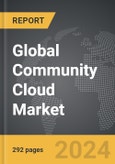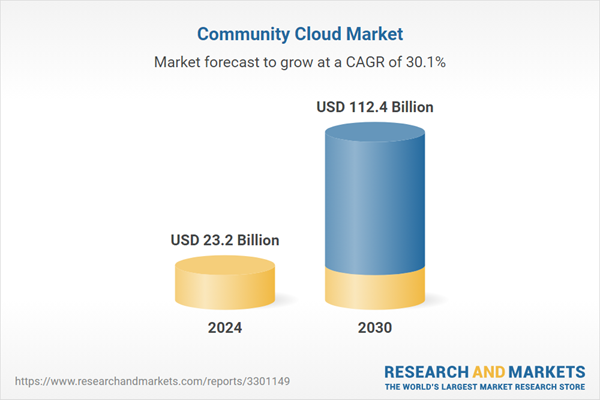The global market for Community Cloud was valued at US$23.2 Billion in 2024 and is projected to reach US$112.4 Billion by 2030, growing at a CAGR of 30.1% from 2024 to 2030. This comprehensive report provides an in-depth analysis of market trends, drivers, and forecasts, helping you make informed business decisions. The report includes the most recent global tariff developments and how they impact the Community Cloud market.
Community clouds are especially advantageous in sectors with similar regulatory challenges and operational requirements. For instance, government departments can share infrastructure and services securely, facilitating better communication and data sharing without compromising security. In healthcare, community clouds enable seamless sharing of patient records across hospitals and providers, adhering to regulations such as HIPAA, thus improving patient care. Educational institutions also leverage community clouds to share resources and services efficiently, reducing costs and enhancing the online learning experience. The structure of a community cloud includes key components such as shared policies and protocols, cloud infrastructure often built on a private cloud base, a cloud management system for resource and security management, identity and access management (IAM) systems, data governance tools, and shared application services, all tailored to meet the specific needs of its members.
Several key drivers are fueling the growth of community clouds. The integration of advanced technologies such as artificial intelligence (AI) and big data analytics enhances the functionality of community clouds, enabling smarter data-driven decisions and personalized user experiences. Regulatory compliance needs in sectors like healthcare and finance make community clouds attractive due to their alignment with stringent data privacy and security laws such as GDPR and HIPAA. The extensive customization options offered by community cloud platforms allow organizations to tailor services to their unique operational requirements. The shared cost model is significant for sectors with tight budgets, allowing access to high-level cloud computing resources without the high capital expenditure of private clouds. Community clouds foster sector-specific engagement, enabling users to share best practices and develop solutions collaboratively. Additionally, community clouds contribute to environmental sustainability by optimizing resource use and reducing carbon footprints compared to isolated private clouds. The shift towards remote work and digital collaboration further underscores the need for community clouds, which provide seamless platforms for collaboration and data sharing across locations, adapting to modern work cultures. These factors collectively drive the adoption of community cloud solutions across various industries, highlighting the complex interplay of technology, regulatory compliance, economic considerations, and cultural shifts.
Segments: Component (Software, Hardware); Application (Cloud Storage, Cloud Backup & Recovery, Cloud Security & Data Privacy, Web-Based Applications, High-Performance Computation (HPC) & Analytics); Vertical (BFSI, Gaming, Healthcare, Government, Academia & Education, Other Verticals).
Geographic Regions/Countries: World; United States; Canada; Japan; China; Europe (France; Germany; Italy; United Kingdom; and Rest of Europe); Asia-Pacific; Rest of World.
The analysts continuously track trade developments worldwide, drawing insights from leading global economists and over 200 industry and policy institutions, including think tanks, trade organizations, and national economic advisory bodies. This intelligence is integrated into forecasting models to provide timely, data-driven analysis of emerging risks and opportunities.
Global Community Cloud Market - Key Trends and Drivers Summarized
In the realm of cloud computing, the community cloud model allows multiple organizations to share resources and services to meet common operational and regulatory requirements. These organizations, often from the same industry or with similar data and service needs, benefit from a shared infrastructure that offers more security and compliance than public clouds and is less expensive than private clouds. This makes community clouds particularly suitable for sectors such as healthcare, education, financial services, and legal fields where privacy and compliance are critical. The architecture of community clouds combines elements of both private and public clouds, focusing on enhanced security and shared data services. These clouds can be hosted internally by consortium members or externally by third-party vendors, involving complex setups that include shared policies, security protocols, and allocation strategies to ensure equitable benefits and compliance with industry standards.Community clouds are especially advantageous in sectors with similar regulatory challenges and operational requirements. For instance, government departments can share infrastructure and services securely, facilitating better communication and data sharing without compromising security. In healthcare, community clouds enable seamless sharing of patient records across hospitals and providers, adhering to regulations such as HIPAA, thus improving patient care. Educational institutions also leverage community clouds to share resources and services efficiently, reducing costs and enhancing the online learning experience. The structure of a community cloud includes key components such as shared policies and protocols, cloud infrastructure often built on a private cloud base, a cloud management system for resource and security management, identity and access management (IAM) systems, data governance tools, and shared application services, all tailored to meet the specific needs of its members.
Several key drivers are fueling the growth of community clouds. The integration of advanced technologies such as artificial intelligence (AI) and big data analytics enhances the functionality of community clouds, enabling smarter data-driven decisions and personalized user experiences. Regulatory compliance needs in sectors like healthcare and finance make community clouds attractive due to their alignment with stringent data privacy and security laws such as GDPR and HIPAA. The extensive customization options offered by community cloud platforms allow organizations to tailor services to their unique operational requirements. The shared cost model is significant for sectors with tight budgets, allowing access to high-level cloud computing resources without the high capital expenditure of private clouds. Community clouds foster sector-specific engagement, enabling users to share best practices and develop solutions collaboratively. Additionally, community clouds contribute to environmental sustainability by optimizing resource use and reducing carbon footprints compared to isolated private clouds. The shift towards remote work and digital collaboration further underscores the need for community clouds, which provide seamless platforms for collaboration and data sharing across locations, adapting to modern work cultures. These factors collectively drive the adoption of community cloud solutions across various industries, highlighting the complex interplay of technology, regulatory compliance, economic considerations, and cultural shifts.
Report Scope
The report analyzes the Community Cloud market, presented in terms of units. The analysis covers the key segments and geographic regions outlined below.Segments: Component (Software, Hardware); Application (Cloud Storage, Cloud Backup & Recovery, Cloud Security & Data Privacy, Web-Based Applications, High-Performance Computation (HPC) & Analytics); Vertical (BFSI, Gaming, Healthcare, Government, Academia & Education, Other Verticals).
Geographic Regions/Countries: World; United States; Canada; Japan; China; Europe (France; Germany; Italy; United Kingdom; and Rest of Europe); Asia-Pacific; Rest of World.
Key Insights:
- Market Growth: Understand the significant growth trajectory of the Hardware segment, which is expected to reach US$56.3 Billion by 2030 with a CAGR of a 33.5%. The Software segment is also set to grow at 27.2% CAGR over the analysis period.
- Regional Analysis: Gain insights into the U.S. market, valued at $6.8 Billion in 2024, and China, forecasted to grow at an impressive 28.6% CAGR to reach $16.6 Billion by 2030. Discover growth trends in other key regions, including Japan, Canada, Germany, and the Asia-Pacific.
Why You Should Buy This Report:
- Detailed Market Analysis: Access a thorough analysis of the Global Community Cloud Market, covering all major geographic regions and market segments.
- Competitive Insights: Get an overview of the competitive landscape, including the market presence of major players across different geographies.
- Future Trends and Drivers: Understand the key trends and drivers shaping the future of the Global Community Cloud Market.
- Actionable Insights: Benefit from actionable insights that can help you identify new revenue opportunities and make strategic business decisions.
Key Questions Answered:
- How is the Global Community Cloud Market expected to evolve by 2030?
- What are the main drivers and restraints affecting the market?
- Which market segments will grow the most over the forecast period?
- How will market shares for different regions and segments change by 2030?
- Who are the leading players in the market, and what are their prospects?
Report Features:
- Comprehensive Market Data: Independent analysis of annual sales and market forecasts in US$ Million from 2024 to 2030.
- In-Depth Regional Analysis: Detailed insights into key markets, including the U.S., China, Japan, Canada, Europe, Asia-Pacific, Latin America, Middle East, and Africa.
- Company Profiles: Coverage of players such as Akamai Technologies, Inc., Amadeus IT Group SA, Amazon Web Services, Inc., Atos SA, Cisco Systems, Inc. and more.
- Complimentary Updates: Receive free report updates for one year to keep you informed of the latest market developments.
Some of the 38 companies featured in this Community Cloud market report include:
- Akamai Technologies, Inc.
- Amadeus IT Group SA
- Amazon Web Services, Inc.
- Atos SA
- Cisco Systems, Inc.
- Google Cloud Platform
- IBM Corporation
- Microsoft Corporation
- Vmware, Inc.
Tariff Impact Analysis: Key Insights for 2025
Global tariff negotiations across 180+ countries are reshaping supply chains, costs, and competitiveness. This report reflects the latest developments as of April 2025 and incorporates forward-looking insights into the market outlook.The analysts continuously track trade developments worldwide, drawing insights from leading global economists and over 200 industry and policy institutions, including think tanks, trade organizations, and national economic advisory bodies. This intelligence is integrated into forecasting models to provide timely, data-driven analysis of emerging risks and opportunities.
What’s Included in This Edition:
- Tariff-adjusted market forecasts by region and segment
- Analysis of cost and supply chain implications by sourcing and trade exposure
- Strategic insights into geographic shifts
Buyers receive a free July 2025 update with:
- Finalized tariff impacts and new trade agreement effects
- Updated projections reflecting global sourcing and cost shifts
- Expanded country-specific coverage across the industry
Table of Contents
I. METHODOLOGYII. EXECUTIVE SUMMARY2. FOCUS ON SELECT PLAYERSIII. MARKET ANALYSISIV. COMPETITION
1. MARKET OVERVIEW
3. MARKET TRENDS & DRIVERS
4. GLOBAL MARKET PERSPECTIVE
UNITED STATES
CANADA
JAPAN
CHINA
EUROPE
FRANCE
GERMANY
ITALY
UNITED KINGDOM
REST OF EUROPE
ASIA-PACIFIC
REST OF WORLD
Companies Mentioned (Partial List)
A selection of companies mentioned in this report includes, but is not limited to:
- Akamai Technologies, Inc.
- Amadeus IT Group SA
- Amazon Web Services, Inc.
- Atos SA
- Cisco Systems, Inc.
- Google Cloud Platform
- IBM Corporation
- Microsoft Corporation
- Vmware, Inc.
Table Information
| Report Attribute | Details |
|---|---|
| No. of Pages | 292 |
| Published | April 2025 |
| Forecast Period | 2024 - 2030 |
| Estimated Market Value ( USD | $ 23.2 Billion |
| Forecasted Market Value ( USD | $ 112.4 Billion |
| Compound Annual Growth Rate | 30.1% |
| Regions Covered | Global |









